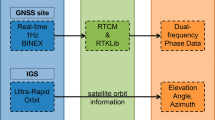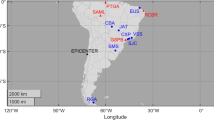Abstract
The Co-Seismic Ionospheric Disturbance of the 2015 Nepal earthquake is analyzed in this paper. GNSS data are used to obtain the Satellite-Station TEC sequences. After removing the de-trended TEC variation, a clear ionospheric disturbance was observed 10 min after the earthquake, while the geomagnetic conditions, solar activity, and weather condition remained calm according to the Kp, Dst, F10.7 indices and meteorological records during the period of interest. Computerized ionosphere tomography (CIT) is then used to present the tridimensional ionosphere variation with a 10-min time resolution. The CIT results indicate that (1) the disturbance of the ionospheric electron density above the epicenter during the 2015 Nepal earthquake is confined at a relatively low altitude (approximately 150–300 km); (2) the ionospheric disturbances on the west side and east sides of the epicenter are precisely opposite. A newly established electric field penetration model of the lithosphere–atmosphere–ionosphere coupling is used to investigate the potential physical mechanism.









Similar content being viewed by others
References
Afraimovich EL et al (2010) TEC response to the 2008 Wenchuan earthquake in comparison with other strong earthquakes. Int J Remote Sens 31(13):3601–3613
Astafyeva E, Shalimov S, Olshanskaya E, Lognonné P (2013) Ionospheric response to earthquakes of different magnitudes: larger quakes perturb the ionosphere stronger and longer. Geophys Res Lett 40:1675–1681. https://doi.org/10.1002/grl.50398
Avinash CK, Malcolm S (1988) Principles of computerized tomographic imaging. IEEE Press, New York, pp 275–296
Bolt BA (1964) Seismic air waves from the great 1964 Alaskan earthquake. Nature 202(4937):1095–1096
Calais E, Minster JB (1995) GPS detection of ionospheric perturbations following the January 17 1994 Northridge earthquake. Geophys Res Lett 22(9):1045–1048
Cervone G et al (2006) Surface latent heat flux and nighttime LF anomalies prior to the \(\text{ Mw }=8.3\) Tokachi-Oki earthquake. Nat Hazards Earth Syst Sci 6:109–114
Chen P, Yao YB, Yao W (2016) On the coseismic ionospheric disturbances after the Nepal Mw7.8 earthquake on April 25, 2015 using GNSS observations. Adv Space Res 59(1):103–113
Davies K, Baker DM (1965) Ionospheric effect observed around the time of the Alaskan earthquake of March 28 1964. J Geophys Res 70(9):2251–2253
Freund FT, Kulahci IG, Cyr G, Ling J, Winnick M, Tregloan-Reed J, Freund MM (2009) Air ionization at rock surfaces and pre-earthquake signals. J Atmos Sol Terr Phys 71:1824–1834. https://doi.org/10.1016/j.jastp.2009.07.013
Hansen AJ (1998) Real-time ionospheric tomography using terrestrial GPS sensors. Proc Inst Navig GPS 98:717–727
Heki K (2011) Ionospheric electron enhancement preceding the 2011 Tohoku-Oki earthquake. Geophys Res Lett 38(17):L17312
Huba JD, Joyce G, Fedder JA (2000) Sami2 is Another Model of the Ionosphere (SAMI2): a new low-latitude ionosphere model. J Geophys Res 105(A10):23035–23053. https://doi.org/10.1029/2000JA000035
Jin SG, Occhipinti G, Jin R (2015) GNSS ionospheric seismology: recent observation evidences and characteristics. Earth Sci Rev 147:54–64
Kamogawa M (2006) Preseismic lithospherec–atmospherec–ionosphere coupling. EOSTrans Am Geophys Union 87(40):417–424
Kamogawa M et al (2015) Does an ionospheric hole appear after an inland earthquake? J Geophys Res Space Phys 120(11):9998–10005
Kon S, Nishihashi M, Hattori K (2011) Ionospheric anomalies possibly associated with \(\text{ M }\geqslant 6.0\) earthquakes in the Japan area during 1998–2010: case studies and statistical study. J Asian Earth Sci 41(4–5):410–420
Kong J et al (2016) A new computerized ionosphere tomography model using the mapping function and an application in study of seismic-ionosphere disturbance. J Geod 90(8):741–755
Kuo CL, Lee LC, Huba J (2014) An improved coupling model for the lithosphere–atmosphere–ionosphere system. J Geophys Res Space Phys 119:3189–3205
Kuo CL, Lee LC, Heki K (2015) Preseismic TEC changes for Tohoku-Oki earthquake: comparisons between simulations and observations. Terr Atmos Ocean Sci 26(1):63–72
Le HJ, Liu JY, Liu LB (2011) A statistical analysis of ionospheric anomalies before 736 M6.0+ earthquakes during 2002–2010. J Geophys Res 116:A02303
Leonard RS, Barnes RA (1965) Observation of ionospheric disturbances following the Alaska earthquake. J Geophys Res 70(5):1250–1253
Liu JY et al (2006) A statistical investigation of pre-earthquake ionospheric anomaly. J Geophys Res 111(A5):304–309
Liu JY et al (2010) Coseismic ionospheric disturbances triggered by the Chic-Chi earthquake. J Geophys Res 115:A08303
Maruyama T et al (2011) Ionospheric multiple stratifications and irregularities induced by the 2011 off the Pacific coast of Tohoku earthquake. Earth Planets Space 63:869–873
Occhipinti G, Komjathy A, Lognonné P (2008) Tsunami detection by GPS: how ionospheric observation might improve the Global Warning System. GPS World 19(2):50–56
Oyama KI et al (2008) Reduction of electron temperature in low latitude ionosphere at 600 km before and after large earthquakes. J Geophys Res 113:A11317
Perevalova NP et al (2014) Threshold magnitude for ionospheric TEC response to earthquakes. J Atmos Sol Terr Phys 108:77–90
Pryse SE, Kersley L (1992) A preliminary experimental test of ionospheric tomography. J Atmos Terr Phys 54(7–8):1007–1012
Pulinets S, Boyarchuk K (2004) Ionospheric precursors of earthquakes. Springer, Berlin
Pulinets S, Davidenko D (2014) Ionospheric precursors of earthquakes and Global Electric Circuit. Adv Space Res 53(5):709–723
Pulinets SA, Boyarchuk KA, Hegai VV, Kim VP, Lomonosov AM (2000) Quasielectrostatic model of atmosphere–thermosphere–ionosphere coupling. Adv Space Res 26(8):1209–1218. https://doi.org/10.1016/S0273-1177(99)01223-5
Reddy CD, Seemala GK (2015) Two-mode ionospheric response and Rayleigh wave group velocity distribution reckoned from GPS measurement following Mw 7.8 Nepal earthquake on 25 April 2015. J Geophys Res Space Phys 120:7049–7059
Ryu K, Lee E, Parrot M, Oyama K-I (2014a) Multisatellite observations of enhancement of equatorial ionization anomaly around Northern Sumatra earthquake of March 2005. J Geophys Res 119:4767–4785
Saroso S et al (2008) Ionospheric GPS TEC anomalies and \(\text{ M } >5.9\) earthquakes in Indonesia during 1993–2002. Terr Atmos Ocean Sci 19(5):481–488
Schmidt M, Bilitza D, Shum CK, Zeilhofer C (2008) Regional 4-D modeling of the ionospheric electron density. Adv Space Res 42(4):782–790
Sorokin VM, Chmyrev VM, Yaschenko AK (2001) Electrodynamic model of the lower atmosphere and the ionosphere coupling. J Atmos Sol Terr Phys 63(16):1681–1691. https://doi.org/10.1016/S1364-6826(01)00047-5
Sorokin VM, Yaschenko AK, Hayakawa M (2007) A perturbation of DC electric field caused by light ion adhesion to aerosols during the growth in seismic-related atmospheric radioactivity. Nat Hazards Earth Syst Sci 7(1):155–163
Sun YY et al (2016) Ionospheric F2 region perturbed by the 25 April 2015 Nepal earthquake. J Geophys Res Space Phys 121:5778–5784
Yao YB et al (2012) Analysis of pre-earthquake ionospheric anomalies before the global \(\text{ M } = 7.0+\) earthquakes in 2010. Nat Hazards Earth Syst Sci 112(3):575–585
Yuen FC et al (1969) Continuous traveling coupling between seismic waves and the ionosphere evident in May 1968 Japan earthquake data. J Geophys Res 74:2256–2264
Zhou C et al (2017) An electric field penetration model for seismo-ionospheric research. Adv Space Res 60(10):2217–2232. https://doi.org/10.1016/j.asr.2017.08.007
Acknowledgements
We acknowledge the CMONOC for providing the GPS data via the GNSS Center at Wuhan University, the UNAVCO for providing the Nepal network data, the IGS for providing the orbit data, and the National Science & Technology Infrastructure of China, National Earth System Science Data Sharing Infrastructure (http://www.geodata.cn), for providing the base maps in this paper. We also thank NASA for providing magnetic index data and the ACE Science Center for providing F10.7 data. This research was financially supported by the National Natural Fund of China (41274022, 41604002, and 41574028), the Fundamental Research Funds for the Central Universities (2042016kf0037), and Key Laboratory of Geo-informatics of State Bureau of Surveying and Mapping Fund (16-02-04).
Author information
Authors and Affiliations
Corresponding author
Rights and permissions
About this article
Cite this article
Kong, J., Yao, Y., Zhou, C. et al. Tridimensional reconstruction of the Co-Seismic Ionospheric Disturbance around the time of 2015 Nepal earthquake. J Geod 92, 1255–1266 (2018). https://doi.org/10.1007/s00190-018-1117-3
Received:
Accepted:
Published:
Issue Date:
DOI: https://doi.org/10.1007/s00190-018-1117-3




